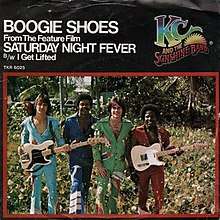Boogie Shoes
"Boogie Shoes" is a song by the disco group KC and the Sunshine Band, released in 1975 on the album KC and the Sunshine Band. The song became a hit after it appeared on the Saturday Night Fever soundtrack in 1977. It peaked at number 35 on the Billboard Hot 100 and number 29 on the soul chart in 1978.[2] The song was originally released as the B-side to the song Shake Your Booty in 1976, before being released as an A-side after its inclusion in Saturday Night Fever.
| "Boogie Shoes" | ||||
|---|---|---|---|---|
 Artwork for 1978 Dutch single, also used for 1978 US vinyl single | ||||
| Single by KC and the Sunshine Band | ||||
| from the album KC and the Sunshine Band | ||||
| A-side | "I Get Lifted" | |||
| Released | December 16, 1975 | |||
| Genre | ||||
| Length | 2:17 | |||
| Label | TK | |||
| Songwriter(s) |
| |||
| Producer(s) |
| |||
| KC and the Sunshine Band singles chronology | ||||
| ||||
Structurally, it uses the sixteen-bar blues chord progression. As with several of KC's disco songs, some of the lyrics are playfully suggestive: "I want to do it till the sun comes up / I want to do it till I can't get enough."
In addition to Saturday Night Fever, the song is featured in numerous other films, including No Escape (1994), Mallrats (1995), Boogie Nights (1997), Detroit Rock City (1999), The Wedding Date (2005) as well as television series, Sports Night, Desperate Housewives (both, coincidentally, with star Felicity Huffman dancing to it), and Flash Forward.
The song has been sampled by The Bloodhound Gang in the song "One Way", and more recently by Trick Daddy in his song "Take It to Da House." Alex Chilton famously covered "Boogie Shoes" on his 1979 album Like Flies on Sherbert. In 2012, the song was sung by Alex Newell (playing a transgender teen) in the Glee episode "Saturday Night Glee-ver".
Personnel
- Harry Wayne Casey – keyboards, vocals
- Jerome Smith – guitar
- Richard Finch – bass guitar
- Robert Johnson – drums
- Oliver C. Brown – percussion
- Ken Faulk – trumpet
- Vinnie Tanno – trumpet
- Mike Lewis – tenor saxophone
- Whit Sidener – baritone saxophone
- Beverly Champion – background vocals
- Margaret Reynolds – background vocals
- Jeanette Williams – background vocals
References
- "KC & The Sunshine Band – Boogie Shoes". Discogs. Retrieved June 18, 2018.
- Whitburn, Joel (2004). Top R&B/Hip-Hop Singles: 1942-2004. Record Research. p. 315.